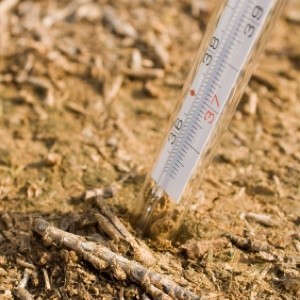
Gardeners can't always rely solely on the calendar to tell them when it's time to plant, especially when it comes to measuring the temperature of the soil. Plants that are started in cold soils may grow slowly, develop poorly, or succumb to disease-IF they ever get off the ground at all! Here's what you need to know about soil temperature and the adverse affects that too-cool soils can have on your plants.
Life is fragile, so seeds are fussy. They are happy to put forth the extraordinary effort needed to produce a plant, providing of course, that the conditions are just right. Soil temperature, light, and moisture all work together to trigger seed germination. When the soil is cold, the seed may not germinate in the ground. If it does, it may be weak and lack the strength and vigor needed to develop properly, and may be at greater risk of succumbing to pests and disease.
Heat is the catalyst for many biological processes. When soil temperatures are low (and biological processes slow), certain nutrients are made unavailable or less available to plants. This is particularly true in the case of phosphorus, which is largely responsible for promoting the development of roots and fruit in plants. So, no heat = less nutrients = poor growth.
The answer to this depends on what type of seeds you are trying to germinate and/or what type of plants you are trying to grow. Most cool season vegetable crops will germinate when soil temperatures reach the mid-40's to mid 50's. They grow best when in daytime air temperatures of between 60-80 degrees F. Warm season vegetables crops prefer soil temperatures in the mid 50's to mid 60's for germination and need summer-like air temperatures (70-95 degrees F) to achieve optimal growth.
Many extension agencies websites and gardening books include charts listing both the minimum and optimum temperature ranges for vegetable seed germination and growth. Here is an example from the Alabama Cooperative Extension System:www.aces.edu
Flower seeds have soil temperature preferences, too. Check the back of seed packets for specific instructions.
An easy way to take the guesswork out of calculating soil temperatures is to use a soil thermometer. From the low-tech dial probes to thermometers with high-tech digital read-outs and automatic shut-off features, most hardware stores and garden centers carry them. Probe thermometers are designed to fit easily into your shirt pocket and are inexpensive ($7-$10).
To take a reading, simply insert the probe into the soil to the appropriate depth--2 inches for small seeds and early season crops, and 4 inches for warm season vegetables like tomatoes. Leave it there for at least 5 minutes before checking the results. Readings should be taken over a period of days, in different locations throughout the garden. Use a journal to record how the temperatures fluctuate daily and which part of your garden warms up first. This will help you when its time to plan next year's garden. Once the temperatures stay at the desired level for 3 days in a row, it is safe to plant.
Mother Natures takes her own sweet time to warm up soil temperatures in the spring. To speed up the process and avoid problems, gardeners can do several things:

About The Author: Ellen Brown is an environmental writer and photographer and the owner of Sustainable Media, an environmental media company that specializes in helping businesses and organizations promote eco-friendly products and services.
Add your voice! Click below to comment. ThriftyFun is powered by your wisdom!
Add your voice! Click below to comment. ThriftyFun is powered by your wisdom!